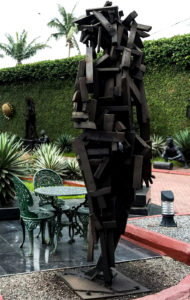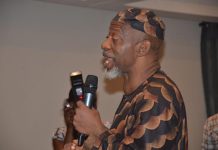First Published in the The Financial Times of London as part of the African Philanthropy series – a series of articles dedicated to showcasing the rise of Africa’s wealthy class, and the greater capacity of some governments to drive growth and development independently, which is giving Africans more say over the type of programmes they want funded
With its 165-year-old tortoise, crested cranes and catfish pond, the high-walled garden at Prince Yemisi Shyllon’s Lagos home would feel magical even without its motionless occupants: more than 400 sculptures in bronze, wood, glass fibre and stone.
From playful village girls to an ethereal giantess, spear-wielding warriors and a drummer boy with a forlorn tale to tell, the phantasmagoria of life-size people, animals and mysterious beings represents the visions of Nigerian sculptors from the pre-colonial era to the present day.
 Now in his mid-60s, having accumulated some 7,000 artworks over the past 40 years, Prince Yemisi, who hails from royal Yoruba heritage, wants to secure his legacy. He is building a gallery bearing his name — the Yemisi Shyllon Museum — to showcase his collectio
Now in his mid-60s, having accumulated some 7,000 artworks over the past 40 years, Prince Yemisi, who hails from royal Yoruba heritage, wants to secure his legacy. He is building a gallery bearing his name — the Yemisi Shyllon Museum — to showcase his collectio
“I looked at what I have and was worried that when I’ve gone everything would go to rot,” Prince Yemisi says, in a shaded corner of his garden, where a bust of a Fulani herdsman made of washers and motorbike chains keeps a stern vigil. “That is why I’m playing the little role I can play.”
In mid-September 2017, workmen perched on rickety scaffolding were busy finishing the striking concrete shell of the two-storey museum. It stands on the campus of Pan-Atlantic University, a private, non-profit institution on the Lekki peninsula to the east of Lagos. The goal is to open in 2019.
Not so long ago, Prince Yemisi’s grant — N600m ($1.7m) towards the cost of building his museum and maintaining it for 15 years — would have marked him as an outlier in Africa, or even a crank. This is no longer the case. Across the continent, from Morocco to South Africa, philanthropists are pouring money into developing a cultural ecosystem, opening museums and sponsoring residencies, art fairs or symposia, and sketching out plans to reinvigorate dilapidated state-owned galleries.
“Governments are not going to start disbursing money for the arts — they have more immediate problems to deal with,” says Ayo Adeyinka, a Nigerian art dealer who founded the Africa-focused Tafeta visual arts agency in London. “We’ve come to the realisation that if we’re going to do this, we have to do it with private funds.”
The outbreak of generosity has occurred at a time when African art is in vogue in London, New York and Paris, with the continent’s leading artists winning international acclaim. But these projects to support painters, sculptors and photographers are more an expression of cultural self-confidence than a reflection of the new enthusiasm for African aesthetics in the West.
“It’s like another kind of colonisation when you need to get your affirmation [from] a museum like the [UK’s] Tate, for example,” says Azu Nwagbogu, founder of the African Artists’ Foundation in Lagos. “We have Africans taking ownership of what’s important and starting to shape the narrative of the continent.”
The impact of philanthropy is most visible in newer institutions like Prince Yemisi’s. Alami Lazraq, the Moroccan property magnate, for example, sponsored the construction of the Museum of African Contemporary Art Al Maaden, which opened 2016 in Marrakesh. By far the highest profile new cultural centre on the continent is South Africa’s Zeitz Museum of Contemporary Art Africa, which opened in September 2017.
Housed in a nine-storey complex, with a stunning atrium built inside converted grain silos, the museum was established through a partnership between the V&A Waterfront development in Cape Town and Jochen Zeitz, the German philanthropist and former chief executive of the sportswear brand Puma, who has loaned his extensive collection of African art to the museum.
 Elana Brundyn, until recently director of institutional advancement and external affairs at Zeitz MOCAA, says the museum will raise the profile of African artists across the continent and beyond.
Elana Brundyn, until recently director of institutional advancement and external affairs at Zeitz MOCAA, says the museum will raise the profile of African artists across the continent and beyond.
“I never thought I would see it in my lifetime,” says Ms Brundyn, a South African gallerist who created her first display space 17 years ago in a milking shed on her parents’ farm outside the town of Durbanville. “I think lots of people are seeing the need to do bigger and better projects.”
In a country that is still navigating the complex legacy of apartheid, the fact that the museum bears the name of a white European has caused some controversy. But Zeitz MOCAA’s supporters hope it will inspire more wealthy Africans to back projects to support the arts.
“Of course, it will always be controversial. But hopefully it’s a wake-up call for fellow Africans to follow suit,” says Monna Mokoena, founder of Gallery MOMO in Johannesburg.
In Lagos, Prince Yemisi’s gallery is winning converts even before opening its doors. Frank Wiggle, head of development and external relations at Pan-Atlantic University, says he began to appreciate Nigerian art only after he saw Prince Yemisi’s collection. He hopes that the museum will have a similarly inspirational effect on the university’s undergraduates.
“All of a sudden I discovered that something other than the football pitch and a nice movie could be interesting,” says Mr Wiggle. “If this can happen to somebody like me, imagine what can happen to thousands of students.”



























